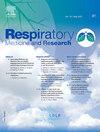在常规间质性肺炎的胸部CT上什么时候检测肌炎抗体?
IF 1.8
4区 医学
Q3 RESPIRATORY SYSTEM
引用次数: 0
摘要
常见性间质性肺炎(UIP)是间质性肺病(ILD)的一种关键类型,最常与特发性肺纤维化(IPF)相关。识别潜在的自身免疫性疾病如肌炎具有临床相关性,但指南对肌炎抗体(MSA)筛查的建议有限。方法回顾性分析在本中心接受系统MSA筛查的UIP患者。比较MSA阳性(MSA+)组和MSA阴性(MSA-)组的临床和血清学特征。采用Logistic回归分析确定预测因素。结果134例患者中MSA+ 15例(11%)。与MSA-患者相比,MSA+患者更容易出现自身免疫性疾病(p = 0.03), ANA≥1:20 20 (p < 0.001),类风湿因子阳性(p = 0.04)。ANA < 1:20 20,无类风湿因子,无高γ球蛋白血症,无雷诺现象的四参数谱能预测MSA阴性,具有良好的特异性(100%),适度的敏感性(35%)和良好的总体判别能力(AUC = 0.82)。在UIP患者中,简单的四参数谱(ANA < 1:320,无类风湿因子,无高γ球蛋白血症,无雷诺现象)强有力地预测了MSA的阴性状态。这些发现支持一种更有针对性的MSA筛查方法,可能提高诊断准确性,指导治疗决策,并减少UIP中不必要的检测。本文章由计算机程序翻译,如有差异,请以英文原文为准。
When to test for myositis antibodies in usual interstitial pneumonia on chest CT?
Introduction
Usual interstitial pneumonia (UIP) is a key pattern of interstitial lung disease (ILD), most commonly linked to idiopathic pulmonary fibrosis (IPF). Identifying underlying autoimmune conditions such as myositis is clinically relevant, yet guidelines provide limited recommendations regarding myositis antibody (MSA) screening.
Methods
We retrospectively analyzed patients with UIP who underwent systematic MSA screening at our center. Clinical and serological characteristics were compared between MSA-positive (MSA+) and MSA-negative (MSA-) groups. Logistic regression was used to identify predictive factors.
Results
Among 134 patients, 15 (11 %) were MSA+. Compared with MSA- patients, MSA+ cases were more likely to present with autoimmune disease (p = 0.03), ANA ≥ 1:320 (p < 0.001), and positive rheumatoid factor (p = 0.04). A four-parameter profile combining ANA < 1:320, absence of rheumatoid factor, no hypergammaglobulinemia, and no Raynaud’s phenomenon strongly predicted MSA negativity with excellent specificity (100 %), modest sensitivity (35 %), and good overall discriminative ability (AUC = 0.82).
Discussion
In patients with UIP, a simple four-parameter profile (ANA < 1:320, absence of rheumatoid factor, absence of hypergammaglobulinemia, and absence of Raynaud’s phenomenon) strongly predicts negative MSA status. These findings support a more targeted approach to MSA screening, potentially improving diagnostic accuracy, guiding treatment decisions, and reducing unnecessary testing in UIP.
求助全文
通过发布文献求助,成功后即可免费获取论文全文。
去求助
来源期刊

Respiratory Medicine and Research
RESPIRATORY SYSTEM-
CiteScore
2.70
自引率
0.00%
发文量
82
审稿时长
50 days
 求助内容:
求助内容: 应助结果提醒方式:
应助结果提醒方式:


